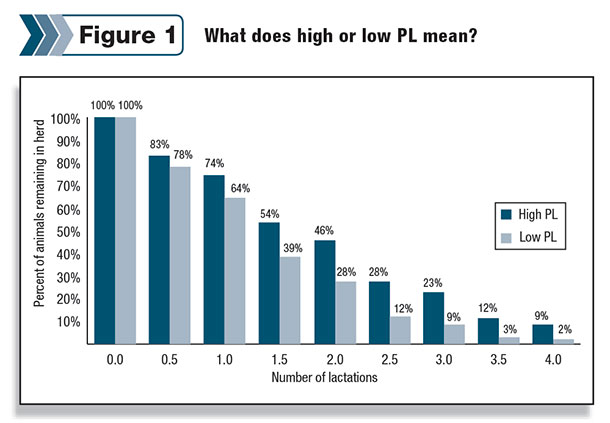In every dairy producer’s ideal world, the norm would be a whole herd of cows that efficiently produces high volumes of milk during several lactations with no transition problems, metabolic diseases, udder health issues or conformation faults leading to an early cull from the herd. In other words, the ideal is a whole herd of “four-event” cows, whose only recorded events throughout a lactation are freshening, a single breeding, pregnancy diagnosis and dry-off.
Management practices and environmental effects certainly have a large impact on the length of time a cow is productive. Cows leave the herd for a number of reasons including reproductive issues, low production, mastitis and lameness, among others.
Regardless of the reason, some cows stay and some cows leave. So we need to ask whether we can use genetics not only to predict which cows will leave the herd and when, but which cows will be the healthiest and most efficient while in production.
What is productive life?
Predicted transmitting abilities for productive life have been published for all breeds since 1994. Research, refinement and adjustments since then have improved the trait’s accuracy.
The actual measure of productive life is how many months longer a cow is predicted to be productive than her herdmates. Because we don’t have an exact value for a cow’s longevity until she dies, other correlated traits such as daughter pregnancy rate, calving ability, somatic cell score, production traits and udder composite are all used to make early predictions for productive life as reliable as possible before a bull’s daughters have all been culled.
In today’s economy, productive life is often associated with old cows. Many farmers recognize that old cows aren’t always the most profitable to keep in a herd, especially when the market dictates that well-conditioned cull cows are worth nearly the same as a replacement heifer.
In fact, culling old cows can provide a big opportunity to improve the herd, since the above-average cows are rarely the ones culled. However, selection for productive life doesn’t just mean more old cows; it also predicts which cows are toughest and easiest to manage: the four-event cows.
The real numbers
Looking at real data, it becomes clear that productive life is a true measure of a cow’s ability to remain productive. An analysis looking at a cross-section of U.S. herds helped determine whether genetic predictions for productive life were matching up with actual phenotypic longevity in a herd.
First, all daughters of the top 10 industry sires for productive life, which average 6.2 productive life units, were separated into one group, and all daughters from the bottom 10 industry sires, averaging -4.3 productive life units, were separated into a different group.
A comparison showing the percentage of daughters remaining in the herd from each group at the middle and end of their first four lactations is shown in Figure 1 . It’s clear to see in the figure that, by the end of two lactations, those who utilized high productive life number sires needed 18 percent fewer replacements to maintain herd size than those who included low productive life number sires into their breeding program.

Will I notice a difference in productive life in my herd?
Many factors on an individual herd level indicate how long a cow will last and how healthy she is while she’s there. Fresh cow problems like displaced abomasums, ketosis and retained placentas, as well as lameness or mastitis, are all shown to be correlated with productive life.
These events not only have an impact on overall longevity but also have a direct cost associated with treatment and lost milk. The real question isn’t necessarily whether productive life always makes cows last longer, but if it makes them healthier and more productive while in the herd.
In an analysis of a 2,000-cow dairy over a one-year time span, all cows in production were sorted into quartiles based on their parent average for productive life. The high productive life number group averaged 2.2 productive life units and the low group averaged -0.7 productive life units.
As Table 1 shows, fewer animals in the high productive life number group had fresh cow problems, abortions and cases of lameness and mastitis, even though there were more freshenings within the high productive life number group.

The correlation between productive life and herd health is evident. While these health events do not each have a direct impact on a sire’s actual productive life numbers, it’s clear to see that higher productive life leads to more of the healthy, four-event cows with increased efficiencies and a lower vet bill.
Even though productive life is certainly not the only trait to consider when determining a breeding program and deciding on which traits to focus, there are a few things to remember:
1. Higher productive life numbers clearly lead to cows producing longer within the herd, meaning fewer replacements are required to maintain herd size.
2. Increased productive life has a direct correlation with a lower incidence of fresh cow problems, lameness and mastitis, all issues that affect a dairy’s bottom line.
3. Today’s dairy economy does not favor high weights on productive life. However, it is highly unlikely that the economic conditions will remain the same for the next four to five years, which is when females resulting from today’s breeding decisions will complete their first lactation. The real benefits of using high productive life number sires now will be reaped at that point.
4. Considering productive life within a balanced genetic plan will aid in productive longevity and increased economic efficiencies within a herd. PD
Chrissy Meyer is also with Alta Genetics.

Nate Zwald
U.S. Sales Manager
Alta Genetics







